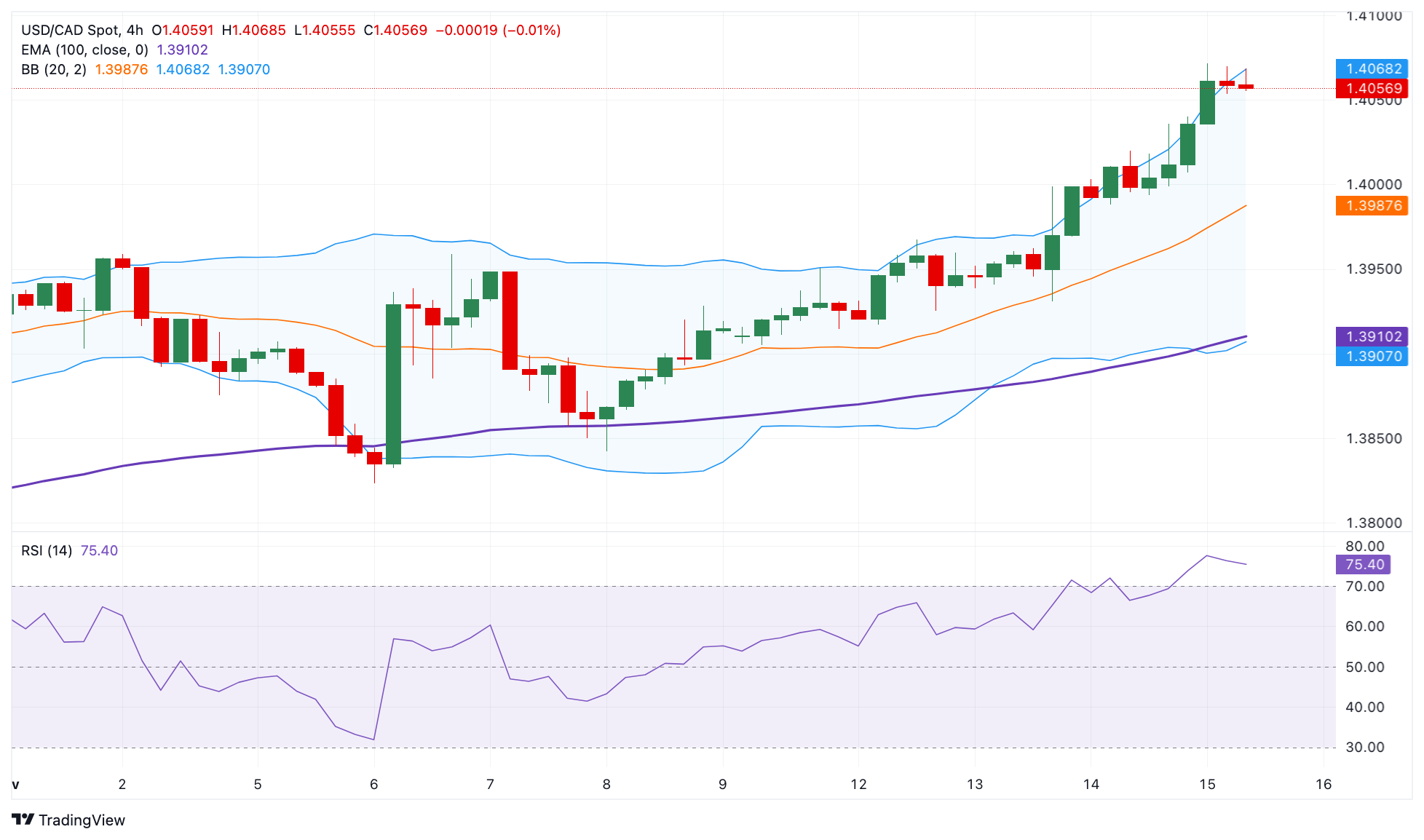USD/CAD Price Forecast: The pair consolidates above 1.4050 amid the overbought condition


- USD/CAD trades flat around 1.4065 in Friday’s early European session.
- The positive bias of the pair prevails above the 100-period EMA, but the overbought RSI condition might cap its upside.
- The immediate resistance level emerges at 1.4070; the first downside target to watch is 1.4000.
The USD/CAD pair holds steady near 1.4065 during the early European session on Friday. However, the renewed US Dollar (USD) demand could provide some support to the pair for the time being. Additionally, the decline in crude oil prices might weigh on the Canadian Dollar (CAD) as Canada is the largest oil exporter to the United States (US).
According to the daily chart, the constructive outlook of the USD/CAD remains intact as the pair holds above the key 100-period Exponential Moving Averages (EMA). However, the 14-day Relative Strength Index (RSI) stands above the midline near 77.65, indicating the overbought RSI condition. This suggests that further consolidation cannot be ruled out before positioning for any near-term USD/CAD appreciation.
The upper boundary of the Bollinger Band at 1.4070 acts as an immediate resistance level for the pair. A decisive break above this level could see a rally to the 1.4100 psychological level, en route to 1.4173 (the high of May 7, 2020).
On the flip side, the initial support level is located at 1.4000, the round mark. A breach of this level could expose 1.3969, the low of November 13. The crucial contention level to watch is the 1.3905-1.3900 zone, representing the confluence of the lower limit of the Bollinger Band and the 100-period EMA.
USD/CAD 4-hour chart

Canadian Dollar FAQs
What key factors drive the Canadian Dollar?
The key factors driving the Canadian Dollar (CAD) are the level of interest rates set by the Bank of Canada (BoC), the price of Oil, Canada’s largest export, the health of its economy, inflation and the Trade Balance, which is the difference between the value of Canada’s exports versus its imports. Other factors include market sentiment – whether investors are taking on more risky assets (risk-on) or seeking safe-havens (risk-off) – with risk-on being CAD-positive. As its largest trading partner, the health of the US economy is also a key factor influencing the Canadian Dollar.
How do the decisions of the Bank of Canada impact the Canadian Dollar?
The Bank of Canada (BoC) has a significant influence on the Canadian Dollar by setting the level of interest rates that banks can lend to one another. This influences the level of interest rates for everyone. The main goal of the BoC is to maintain inflation at 1-3% by adjusting interest rates up or down. Relatively higher interest rates tend to be positive for the CAD. The Bank of Canada can also use quantitative easing and tightening to influence credit conditions, with the former CAD-negative and the latter CAD-positive.
How does the price of Oil impact the Canadian Dollar?
The price of Oil is a key factor impacting the value of the Canadian Dollar. Petroleum is Canada’s biggest export, so Oil price tends to have an immediate impact on the CAD value. Generally, if Oil price rises CAD also goes up, as aggregate demand for the currency increases. The opposite is the case if the price of Oil falls. Higher Oil prices also tend to result in a greater likelihood of a positive Trade Balance, which is also supportive of the CAD.
How does inflation data impact the value of the Canadian Dollar?
While inflation had always traditionally been thought of as a negative factor for a currency since it lowers the value of money, the opposite has actually been the case in modern times with the relaxation of cross-border capital controls. Higher inflation tends to lead central banks to put up interest rates which attracts more capital inflows from global investors seeking a lucrative place to keep their money. This increases demand for the local currency, which in Canada’s case is the Canadian Dollar.
How does economic data influence the value of the Canadian Dollar?
Macroeconomic data releases gauge the health of the economy and can have an impact on the Canadian Dollar. Indicators such as GDP, Manufacturing and Services PMIs, employment, and consumer sentiment surveys can all influence the direction of the CAD. A strong economy is good for the Canadian Dollar. Not only does it attract more foreign investment but it may encourage the Bank of Canada to put up interest rates, leading to a stronger currency. If economic data is weak, however, the CAD is likely to fall.





